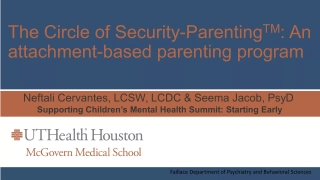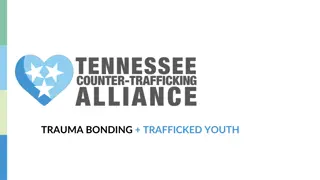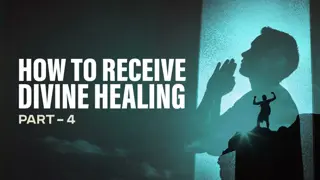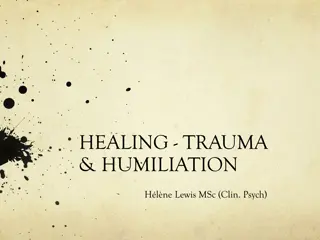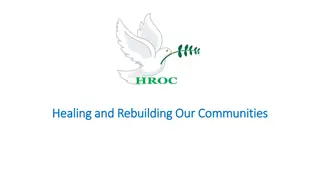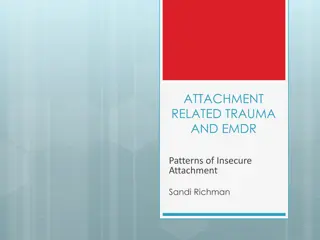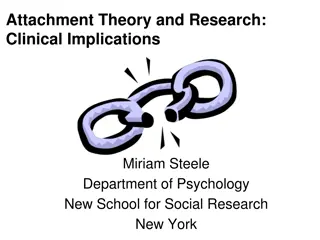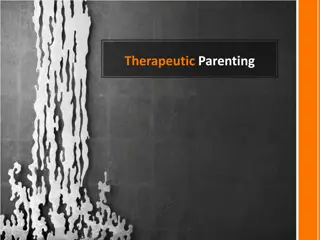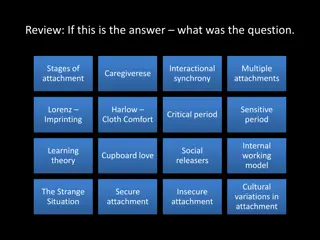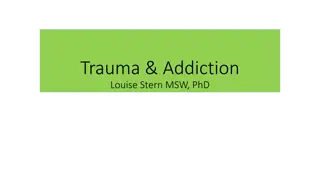Understanding Attachment Trauma and Healing Process
Attachment trauma involves disruptions in forming bonds, leading to complex trauma that affects neurological development. Therapy aims to create compassionate healing opportunities for individuals struggling with attachment-based trauma, addressing both big and little "t" traumas to increase emotional regulation and relationship stability.
Download Presentation

Please find below an Image/Link to download the presentation.
The content on the website is provided AS IS for your information and personal use only. It may not be sold, licensed, or shared on other websites without obtaining consent from the author. Download presentation by click this link. If you encounter any issues during the download, it is possible that the publisher has removed the file from their server.
E N D
Presentation Transcript
Healing from Attachment Based Trauma Alice Stricklin, LMFT www.alicestricklin.com
Objectives 1. Define attachment trauma 2. Identify a treatment plan for attachment based trauma 3. Identify the role of the therapist in the healing process 4. Creating opportunity for compassion in the healing process
What is Attachment Trauma Attachment trauma can be considered any situation in which there is a significant disruption in the formation of the attachment bond. Separation from primary care giver through death, jail time, etc. Watching violence done to primary caregiver (witnessing Domestic Violence) Experiencing overt abuse (physical, sexual, emotional) from primary caregiver Experiencing neglect from primary care giver (basic needs, emotional) Mental Health Issues of Primary Caregiver which creates chaotic and inconsistent attachment patterns.
Complex Trauma When trauma is a violation of human connection , it is significantly more severe. Judith Herman PhD, MD There is no greater trauma than to be wounded by the very people we count on to support and protect us. Sue Johnson When trauma emanates from within the family, children experience a crisis of loyalty and organize their behavior to survive within their families. Being prevented from articulating what they observe and experience, traumatized children will organize their behavior around keeping the secret, deal with their helplessness with compliance or defiance, and accommodate in any way they can to entrapment in abusive or neglectful situations Bessel A. van der Kolk
Neurological Impact There is a growing body of evidence from neurodevelopmental research that shows traumatized children s brains actually develop differently than those of emotionally healthy children. The brain chemistry is altered (increased cortisol, increased adrenaline, then eventually decreased adrenaline). And the actual brain structure can be adversely impacted. Bruce Perry, Bessel van der Kulk
Differentiating Trauma Big T Trauma- Meets criterion for PTSD little t Trauma - Relationship breeches, emotional neglect, life events, chronic disfunction in a system.
Smaller Window of Tolerance Early attachment injuries become patterns of trauma response that can make it difficult for clients to stay in the window of tolerance (WOT). Clients who have early experiences of attachment trauma dissociate at the time and create patterns of dissociating when under stress. This creates a lower tolerance for emotional regulation and has an impact on relationships.
Flipping Our Lid Dan Siegel The Hand Model Dan Siegel s Hand Model
Attachment Wound Adaptations Helped us stay safe or attached at one time. Become our strength, go to way of managing. Are now patterns that feel like the only option of reality. Keep us from getting the thing we want the most. Create what we don t want. Manifest in our physical body. Hold us back. Keep us from being who God created us to be.
The Answer Stay Stay Safe Connected Window of tolerance Boot camp DNA Family Culture Genetic Predisposition Innate trauma response
We cant handle the truth of the moment Get Busy Addictions Before the truth sets you free, it tends to make you miserable. Richard Rohr Laugh/be funny Disappear Truth Submit/ Be Nice Merge Get Angry Lie Minimize We develop ways to stay away from it
Creating the Treatment Plan Phases of Treatment at a glance: Assessment and Safety Safety and Resources Desensitizing the Trauma Planning for the Future
Trauma Treatment Plan Character Strategies Resourcing What is the symptom that is interrupting their current life? When did this develop? Choosing a methodology to address the trauma
Trauma Treatment Models EMDR Therapy (Eye Movement Desensitization and Reprocessing) Exposure Response Therapy TFCBT (Trauma Focused Cognitive Behavior Therapy) for under 18 Trauma Narrative Therapy Trauma Informed Expressive Art Therapy IFS (Internal Family Systems) Brainspotting Hypnosis CBT Neurofeedback These are just some of the many models
Assessment and Safety ASSESSMENT SAFETY Adult Attachment Inventory Create Safety with safety plans as needed PTSD assessments Create Safety by NOT talking about the trauma yet Identify The Answer Create Safety by being consistent, genuine, and caring DES (Dissociative Experience Scale) Create Safety by establishing treatment goals (collaborative) Assess for sleep, suicidality, substance use/abuse, self harm ACES Adverse Childhood Experience Study
Safety and Resources Assess WOT Use Assessment of Readiness Work on Underdeveloped areas by assigning homework, doing interventions one step at a time Assess for ability to utilize resources and if it manages symptoms. (Arnes Three Tests) The Every Day Test The Safe Place Test The History Test
Safety First If Safety for client or others is a current concern, create networks and safety plans (i.e. get them in AA with a sponsor, identify safe person to help with in home safety, build their social network, do they need higher level of care first?)
Basic Resourcing (Widening the WOT) Mindfulness Awareness Calm/Safe Place (Francine Shapiro 2001) Butterfly hug (Lucina Artigas 2000) Container Exercise (Murray 2011) Deep Breathing Progressive Muscle Relaxation (there s an App for that) Distancing ( the largest football stadium ; Rheostat- dimmer switch; Dissociative Table Technique (Fraser 91), Watching a Movie with remote)
Demonstration The Largest Football Field
Somatic Resourcing Body Containing Weighted Blanket Progressive Muscle Relaxation Alignment Exercise Pendulation Yoga Poses Postures
Demonstration Pendulation
Spiritual Resourcing If a client has a strong spiritual practice (e.g. Buddhism, Christian, Contemplative, Nature, etc.) explore ways to enhance this. Use the client s language Transitional Objects (Candle, Crystals, Medalion, Cross, etc.) Find out what is important about their faith or value system and how would that apply or speak to them now? Attachment to Jesus (by Alice Stricklin) Covenant Community (by Alice Stricklin) (If this is an area of struggle for a client, this may not be the best way to help resource. The idea is to help strengthen what is already there. )
* Plutchik, Robert (1980), Emotion: Theory, research, and experience: Vol. 1. Theories of emotion, 1, New York: Academic * Plutchik, Robert (2002), Emotions and Life: Perspectives from Psychology, Biology, and Evolution, Washington, DC: American Psychological Association * Plutchik, Robert; R. Conte., Hope (1997), Circumplex Models of Personality and Emotions, Washington, DC: American Psychological Association Robert Plutchik s Wheel of Emotion
Getting the History Trauma Egg (Murray 91) Trauma Timeline Target Sequencing (EMDR) Genogram (trauma related) (Bowen, M.)
Desensitizing the Trauma a.Trauma Narrative - Write the incident out every day for 4 days for 15 minutes each day. - Narrative Exposure therapy a.Empty Chair (Gestalt) b.Working with Distortions (psychoeducation) c.Future Pull Technique (Victor Frankl)
Desensitizing the Trauma Creative Therapies Now and how you want it to be a.Painting the Trauma (Cathy Malchiodi) b.Art Therapy (Trauma Mandala) c.Music about the trauma (Make a play list) d.Sculpting the Trauma
Planning for the Future Future Template Write a narrative of the future with the trauma as just a chapter Draw/paint the future Sculpt the future without the current symptoms Find music to represent how you would like to be
The Role of the Therapist Safety Offer Choices Container Attunement Safe attachment figure Offer opportunities for different
The Base of Effective Therapy Curiosity, Inviting, Welcoming what's here Present Moment Awareness Healing only happens now Mindfulness Nonviolence Compassion Awareness Assuming client wants health Understandin g is loving Self awareness by clinician How the clinician gets in the way Safety has to be first
The Nonviolent Therapist Recognizes she/he has no control over the client or ability to do anything to them. Recognizes you can only offer and invite an opportunity. ( the usual verbiage that we were taught, "stabilize the client" doesn't work.) Recognizes we can only offer opportunities and help them to develop the ability to stabilize, either by co-regulating or auto- regulating. Recognizes you are not their savior.
The Nonviolent Therapist Offers gentleness Offers Patience Offers permission to do something different Knows their own triggers and sets them aside when they arise Works with the client s own system that is designed to move towards healing.
Welcoming Compassion (Recognizing Patterns) Whatever your client does will happen in your office. Old The Therapist s own patterns patterns The Answer/ The Defense Old triggers Relational Issues
Compassion with the Adaptation Especially concerning working with what some consider resistance. Remember nonviolence. Bringing compassion to what is here. It is an adaptation. You have to have compassion first before the client can. Is there any way this helped you stay alive at some time? or is there any way this helped you stay attached to an important person in your life?
Ways to facilitate Compassion a) Recognize how it was helpful to stay attached or stay alive b) Be Curious about life without it c) Write a letter to the adapted part d) Be curious about other people who have this adaptation .is it ok for them? e) What does the adaptation help them stay away from? f) Personify the adaptation, cartoon it, draw it, etc. g) Write a letter to self from that adaptations point of view.
Summary and Conclusion Necessities to working with Attachment Trauma: Safety with the Therapist Safety in life Resources Identifying adaptations Compassion with Adaptations Processing the trauma
Questions? I m available for: * Leading trainings on various topics * Consulting on cases * Licensure Supervision * EMDR Consultation for Certification My Contact information: Alice Stricklin, LMFT www.alicestricklin.com Alice.stricklin@gmail.com 104 W. Main St. Lebanon, TN 37087


